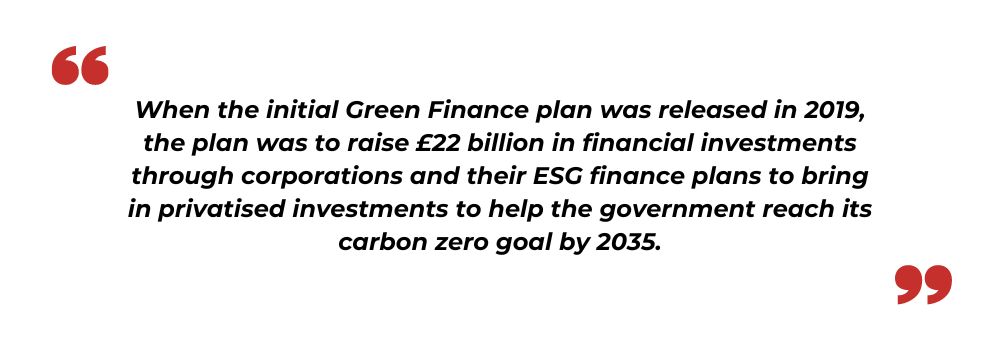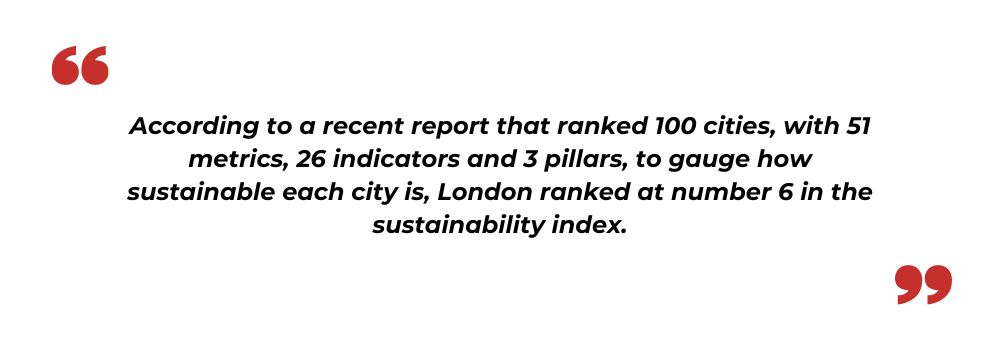When the UK government released their green finance plan to help with reaching sustainable outcomes for the country, there was a lot of hope among corporates and the government officials alike. There have been discrepancies observed in the plan though, which leaves a lot to be desired by the country’s economy.
Before understanding how the UK economy’s green finance plan falls short, let’s first get into understanding what green financing is and how it is supposed to aid the UK finance sector.

What is Green Finance?
Green finance is a document released by the UK government discussing ways in which citizens and corporations that participate in the UK economy can invest more sustainably. The entire purpose of this roadmap is to help companies and the government achieve the same goal - which is becoming carbon neutral by 2035, in accordance with the Paris Agreement.
ESG finance solutions help with the green finance plan for corporates as they come with a sustainability aspect to help them work towards improving their environmental sustainability efforts.
So far, there are three main aspects of the Green Finance plan set out for the UK economy. The three main phases are informing, acting, and shifting.
The informing phase includes building awareness of the information available on sustainability and sustainable investment opportunities to aid greener financial investments. The acting phase involves streamlining all the information that has been made available for investors by the government and including it in the financial decision making process for all companies. The final stage is the shifting stage where the actual shift takes place and all the existing and future business decisions are made by keeping achieving carbon neutrality in mind.
When the initial Green Finance plan was released in 2019, the plan was to raise £22 billion in financial investments through corporations and their ESG finance plans to bring in privatised investments to help the government reach its carbon zero goal by 2035. The aim was to become the first country to become carbon zero before the timeline set by the Paris Agreement.

Now that we understand the basic concept of what Green Finance is and how ESG finances come into play in this situation, let’s take a look at how the UK economy is already falling short in this present scenario.
Why the Green Finance Plan is not Working for the UK Economy
So far, there have been a number of discussions on what the green finance plan is and what it means for corporations and the UK economy, and the impact it would have on the financial situation of the country, but there have been very few reformative actions taking place.
The COP26, which is the UN Climate Change Conference of the Parties, is coming soon where the country will have to present its actionable measures they have undertaken to reach carbon neutrality by (or before, as aimed) 2035. The data so far does not show a lot of improvement in the current scenario and there are major loopholes that exist so far.
.jpg)
Lack of Accountability in Corporations
The first loophole being lack of accountability. Corporations are not accountable for investing in green finance solutions, which means that they do not feel like it is necessary to do so. The only system of accountability they have currently is their ESG finance report that they release to their stakeholders periodically. This is primarily to ensure higher investments and interest among the stakeholders and has no accountability towards the government.
Lack of Financial Plan in Place for Investment
The second problem with the UK's green finance strategy is that there is no real plan to finance the transition towards green financial investment. All the investments regarding green finance require long term goals and missions that can be achieved through a well thought-out, researched, and a data driven plan.
This plan does not exist in its full capacity, which means that those companies and organisations who are looking at researching and investing in green finance for aiding the UK finance sector to become more sustainability-heavy in terms of investments have no viable data or information regarding what to invest in and how to invest. This makes them hesitant to make ESG finance investments that they do not know the returns of.
The first step among many to achieve carbon neutrality is to invest in large scale projects that will take away from fossil fuel consumption and move towards a more carbon zero and renewable source. This requires large scale investments in green energy sources, technology that will support and refine existing renewable energy measures, and more. There needs to be a solid plan that will help organisations find investment options to achieve this outcome.
For example, wind energy generation was up by 9.3% in the first quarter of 2022, according to a report by the UK government. Now, to optimise on the excessive windy conditions in the UK, there needs to be more research and analysis done to find the right technology, or to improve upon existing technology to harness more out of what we have already. This would make the country’s renewable energy generation measures a lot more efficient. Projects like these need to be outlined by the UK government and made public so that investors can invest their finances into helping the government optimise their wind energy and build towards their green finance plan.

There is some silver lining in the picture for this situation though. According to a recent report that ranked 100 cities, with 51 metrics, 26 indicators and 3 pillars, to gauge how sustainable each city is, London ranked at number 6 in the sustainability index. Even though London is one of the most sustainable cities to reside in, it does not take away from the fact that the UK government still needs to achieve a lot more to make the existing Green Finance Plan they have in place a feasible and realistically achievable one.
Lack of Presentation of Risks and Risk Management Plans in the Green Finance Plan
The green finance and ESG finance plan laid out by the UK government so far does not include many physical or financial risks to the investment. It needs to take all these aspects into consideration as well to give investors a well-informed opinion on what the realistic risks are of their investments. It is better to keep all the knowledge out there so that the investors can also plan for any contingencies in case any risk actually manages to manifest. Risk management in financial planning is a key element to any investment opportunity, which is something that is lacking in the current green finance plan.
Read also: Green Finance: The Next Step to Align India's Climate Priorities
Lack of Focus on Opportunities Involved with Making Greener Investments
Another thing that keeps the investors at bay for the green investment plan is that the plan mainly focuses on the costs, instead of focusing on the opportunities. Let’s take this situation as an example:
A man is trying to buy an electric vehicle for himself and his family. He has decided that it is time to take a greener and cleaner approach to his transportation and views his electric vehicle as an investment opportunity that will help him in the future. He goes to the car dealership and he speaks to a salesman. The salesman states all the costs that the man will have to incur in case he decides to purchase the car. The maintenance fees, set up costs, regular charging, electricity bills, battery costs, etc. This spooks the interested buyer into not making the purchase and instead, he chooses to go back and use his car.

Now, if the salesman had spoken about the costs as well as the opportunities that come with purchasing an electric vehicle, the interested buyer would have made the investment. These opportunities could include, evading the rising fuel costs due to having an electric vehicle that does not need petrol or diesel to work. The ease of refuelling, since it can be done at home itself. The way in which he can reduce his and his family’s carbon footprint and contribute to a greener planet. How the family will be a part of the coming new wave of change right at the beginning. How the electric vehicles last longer and require less maintenance because the parts are more durable due to the lack of gas damaging the engine, and so much more.
Now, compare this man and the salesman to the potential private investment opportunities and the UK government. There are willing participants but there are no clear cut opportunities presented to the investors to make the leap.
Final Thoughts
There are many problems with the current Green Finance plan put forward by the UK government, which can be solved by putting forward and executing an action plan for corporations to follow. ESG financing plays a big role in the current economic and environmental climate, which is why companies need to shift their focus to making more sound ESG investments.
SG Analytics offers end-to-end ESG Consulting services to all its clients to meet their sustainability requirements for their financial planning. If you are interested in sourcing data-driven, efficient and accurate information to help you drive better business decisions, contact us, for any and all support.
We have branches in multiple locations across the world spanning from New York, to San Francisco, Austin, Seattle, Toronto, London, Zurich, Pune, Bengaluru, and Hyderabad. SG Analytics is a pioneer in Research and Analytics, offers tailor-made services to enterprises worldwide.









